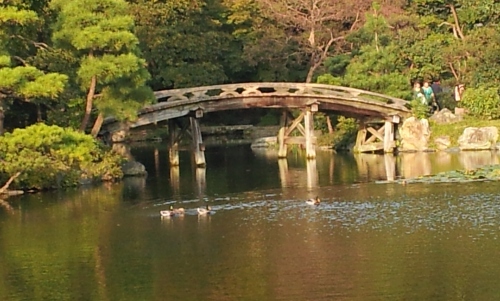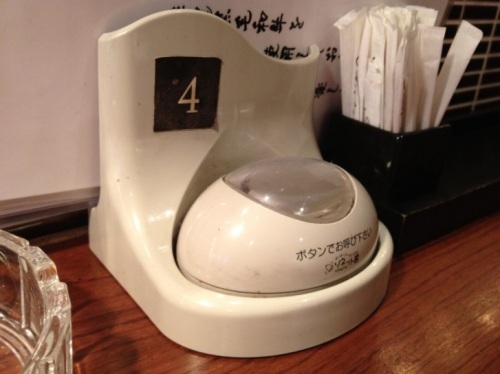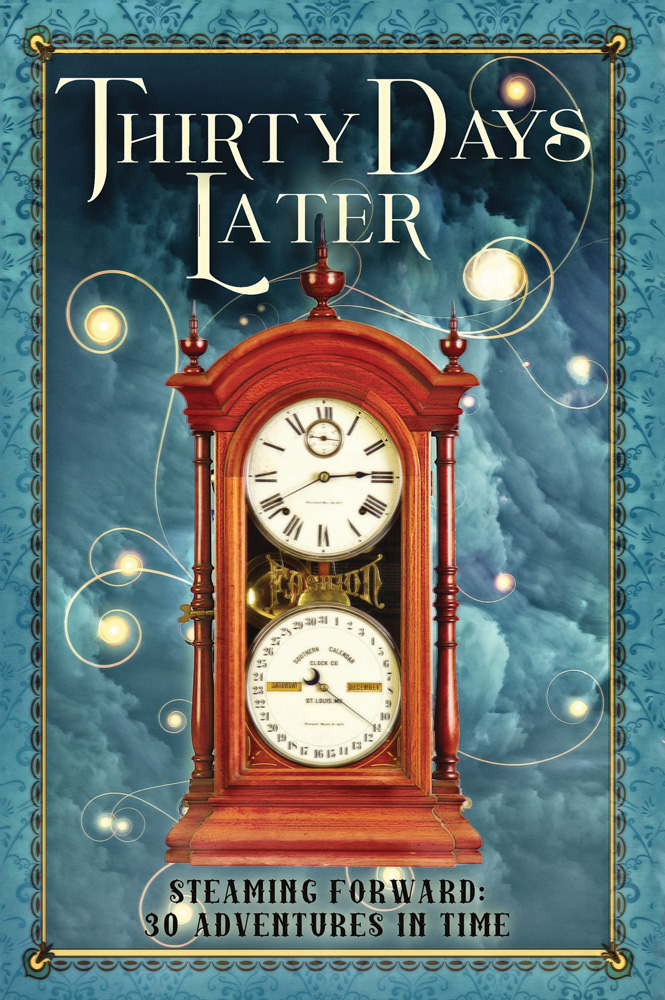by Lillian Csernica on November 24, 2015
The elegant Shosei-en Garden (aka. Kikoku-tei) is located about a short distance east of the Higashi Honjanji temple to which it belongs.
The Garden is originally said to be built on the Heian era site of the Rokujo Kawara-in mansion of Prince Minamoto no Toru, the son of Emperor Saga, in the late 9th century. Later, in 1641, the shogun Tokugawa Iemitsu presented a large parcel of land, which included the garden site, to the Higashi Honganji. In 1643, Sennyo Shonin, the 13th hereditary heir to the Honganji tradition on the Higashi side, commissioned Ishikawa Jozan to create a garden. This marked the beginning of the Shosei-en Garden.
In 1858 and 1864, fires swept the grounds, reducing its structures to ashes. But in 1865 and continuing on into the early years of the Meiji period (1868-1912), the buildings as well as the pond and the magnificent stone wall, were restored to their original condition, as we see them today.

A lovely family having photos taken in the Gardens.
Pat and I crossed the street to visit the Gardens. There’s a 500 yen admission fee that includes a guide full of wonderful photos and information. Unfortunately for us, it’s only in Japanese. Still, it had a map so we did figure out what we were looking at in terms of bridges, tea houses, and the main natural features such as the pond.
In the pond we discovered black koi. A few of them were cruising past the cement curb that borders the pond. So of course I pulled out my bag of “temple cookies” as I took to calling them. I still don’t know what those cookies are made of, but oh man, did those koi go nuts! I asked Pat later and she told me there must have been at least fifty black koi churning up the water pushing each other out of the way to get bits of cookie.
Once again I managed to draw a crowd. There I stood, talking to the koi in a mixture of English and Japanese, tossing pieces of cookie to different areas of the mob. One teenage girl and her mother came close enough that I thought it appropriate to offer her a cookie. With much laughter she broke it up into pieces and tossed it to the happy koi.

Below you see the smaller of the two bridges in the park. I’m proud to say I took this photo myself. It does not come from a professional stock photo site. (The ducks showed no interest in the cookies, which was probably all for the best.)

Shinsetsu-kyo
The afternoon was moving on toward twilight, so the sunlight came in at my favorite glorious end-of-the-movie angle. The small bridge looked so different as the quality of the light changed.

Shinsetsu-kyo, other side.
Now for the big bridge. This one took some effort to get to. I had to cross a small stone bridge, then ascend an uneven stairway made of big blocks of stone. The wooden steps leading up to the bridge were each a bit of a stretch as well. I had to wonder how the Palace and temple officials could possibly move around in the Gardens, given how much yardage Heian Era kimono included. Just keeping their sleeves off the ground would have been a bit of a chore!

There I am on Kaito-ro, a larger bridge with stone steps and beautiful woodwork. It looks like part of a temple.
It was here in Shosei-en Gardens that I met an anomaly. Pat and I came in just behind a group of Japanese men and women who were dressed in business attire. I got the feeling some of the local folks were showing the sights to people not from Kyoto. At one point the path narrowed. The senior gentleman of the group turned and motioned Pat and me to go ahead. I don’t know if it was due to Pat’s cane, or something simpler such as the group taking their time to admire aspects of the Gardens we non-Japanese probably didn’t notice. The point is, in Japan the men go first. I’m sure in these times of international travel and cultural exchange, the gentleman who in effect “held the door” for us was just being polite. Even so, I appreciated his consideration and thanked him with extra-polite Japanese. He had a really wonderful smile.

An empty home altar ready to be equipped.
On the walk back to our hotel we passed all the stores selling all the items a righteous Buddhist might need. I’ve mentioned the stunning variety of prayer beads available. What really blew my mind were the butsudan, or home altars. Large or small, plain or ornate, they were really impressive.

A butsudan complete with a figure of Amida and offerings.
And now, for an entirely different type of educational experience. When we got back to the street with our hotel on it, we stopped in at one of the small restaurants nearby. Things went along in the usual sequence with getting the menus, figuring out what combinations to try, and placing our orders with the server. Pat and I never seem to maintain a reasonable level of “normal” for more than about fifteen minutes. Sure enough, that night it was Pat’s turn to find an all-new way to stir things up.
On our table among the salt, pepper, hot oil, and other unidentifiable condiments, there sat an oval object flat on one side and with a pearly dome on top. It had four little legs on it, and a hatch where the battery fit inside. The battery told me this thing did something, but we could not figure out its actual purpose.

This I now know is a “call button.”
And then, as I handed it back to Pat, I must have gripped it harder than I meant to. This sudden “ting!” came out of nowhere. Honestly, I had no idea where the sound originated. In Japan you are surrounded by electronica, so the sound could have come from somebody’s phone or tablet or the overhead music system.
No sooner had the “ting!” sounded than our server appeared at our table. I swear I never saw her coming, and I sat facing the kitchen. Now we understood. One used the device instead of shouting “Sumimasen!” when one wanted the server’s attention. I tried to apologize. When that didn’t work, because the server expected us to ask for something, I grabbed the first thought that occurred to me: “Mizu, onegaishimasu.” In English, that’s “Water, please.” This caused me some further embarrassment, because not five feet away from me sat a table with a water pitcher and cups so guests could serve themselves. Whoops.
Next time: Toei Kyoto Studio Park, where I met the Shinsengumi!




















Enjoyed the post a lot. Getting to know other culutres, especially when they are so different from us, is sometimes awkward, but always worthwhile 🙂
LikeLiked by 1 person
Pingback: Smorgasbord Reblog – Posts from your Archives – The Shosei-en Gardens (Kyoto Day Two) by Lillian Csernica | Smorgasbord – Variety is the spice of life
Thank you for sharing such beautiful photos and wonderful footnotes about countries we may never get to visit. However, it is wonderful how the internet affords us the opportunity to visit, learn and see how other cultures lifestyles thanks to wonderful people like you. Now if I ever get to visit Japan I will know exactly what that little contraption is for. Thanks. ☺☺☺
LikeLiked by 2 people
You are most welcome. Thank you for visiting my blog, and thank you so much for your kind comments. Kyoto is the city of my heart, and I am so happy to share its wonders.
LikeLiked by 1 person
Reblogged this on anita dawes and jaye marie.
LikeLiked by 1 person
Thank you!
LikeLiked by 1 person
Visiting Kyoto has been at the top of my wish list for years, so I appreciated your photos. AND those black koi!
LikeLiked by 1 person
I’m so happy to know you enjoyed the post! Kyoto is definitely one of the highlights of our world.
LikeLiked by 1 person
I dream of visiting it one day!
LikeLiked by 1 person